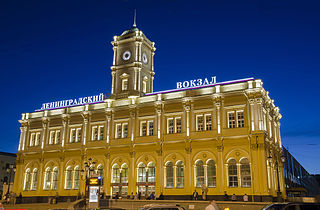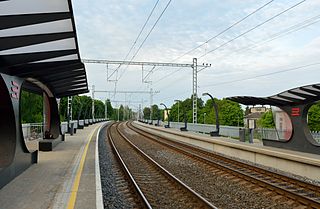
Narva is a municipality and city in Estonia. It is located in Ida-Viru County, at the eastern extreme point of Estonia, at the Russian border, on the Narva River which drains Lake Peipus. The city of Narva is the country's third largest.

AS Eesti Liinirongid, operating as Elron, is a government-owned passenger train operator in Estonia.

Tallinna Linnatranspordi AS (TLT) is a transportation company owned by the city of Tallinn, Estonia. TLT is a result of the merger of Tallinn Bus Company and Tallinn Tram and Trolleybus Company in July 2012. The company provides bus, trolleybus, and tram services in Tallinn.

The Finnish railway network consists of a total of 5,919 km of railways built with 1,524 mm Russian gauge track. Passenger trains are operated by the state-owned VR. They serve all the major cities and many rural areas, though railway connections are available to fewer places than bus connections. Most passenger train services originate or terminate at Helsinki Central railway station, and a large proportion of the passenger rail network radiates out of Helsinki. VR also operates freight services. Maintenance and construction of the railway network itself is the responsibility of the Finnish Rail Administration, which is a part of the Finnish Transport Agency. The network is divided in six areal centres, that manage the use and maintenance of the routes in co-operation. Cargo yards and large stations may have their own signalling systems.

Aegviidu is a borough in Anija Parish, Harju County.

Helsinki Central Station (HEC) is the main station for commuter rail and long-distance trains departing from Helsinki, Finland. The station is used by approximately 400,000 people per day, of which about 200,000 are passengers. It serves as the terminus for all trains in the Helsinki commuter rail network, as well as for all Helsinki-bound long-distance trains in Finland. The Central Railway Station metro station is located in the same building.

Elektrichka is a Soviet and Eastern bloc commuter (regional) mostly suburban electrical multiple unit passenger train. Elektrichkas are widespread in Russia, Ukraine and other countries of the former Warsaw Pact presenting a socially vital mode of transportation. In 2007, 4085 commuter trains a day were running on the Russian Railways network alone, most of them electric. The first elektrichka ran on July 6, 1926, along the Baku–Sabunchi line in Soviet Azerbaijan. Also urban (intra-city) gorodskaya elektrichkas and airport's aeroexpresses exist in a few cities of Russia, Ukraine, and Belarus.

Moscow Leningradsky railway terminal also known as Moscow Passazhirskaya station is the oldest of Moscow's nine railway terminals. Situated on Komsomolskaya Square, the station serves North-Western directions, notably Saint Petersburg. International services from the station include Tallinn, Estonia, operated by GoRail, and Helsinki, Finland.

The rail transport system in Estonia consists of about 1,200 kilometres (750 mi) of railway lines, of which 900 kilometres (560 mi) are currently in public use. The infrastructure of the railway network is mostly owned by the state and is regulated and surveyed by the Estonian Technical Surveillance Authority.

Kalamaja is a subdistrict of the district of Põhja-Tallinn in Tallinn, the capital of Estonia. It is located just northwest of the historical town centre, on the coast of the Tallinn Bay. Kalamaja has a population of 9,820.

Public transport in Tallinn consists of bus, tram, trolleybus, train and ferry services. Bus, tram and trolleybus routes are mainly operated by Tallinna Linnatranspordi AS. Electric train services are offered by Elron and the ferry service to Aegna island is operated by Kihnu Veeteed.

Shalimar railway station is one of five intercity railway stations serving Howrah and Kolkata, India. The other stations are Sealdah in Kolkata, Kolkata station in Kolkata, Howrah Station in Howrah and Santragachi in Howrah. Shalimar station is situated at Shalimar, in Shibpur area of Howrah. It is one of the cleanest, most well-maintained and non-congested railway terminals in the Kolkata Metropolitan Area.

Kelmiküla is a subdistrict in the district of Põhja-Tallinn, Tallinn, the capital of Estonia. It has a population of 1,101.

The history of rail transport in Estonia starts in 1870 when a line was opened connecting Paldiski, Tallinn, Tapa and Narva; the line extending all the way to St. Petersburg in Russia.
The Stert and Westbury Railway was opened by the Great Western Railway Company in 1900 in Wiltshire, England. It shortened the distance between London Paddington station and Weymouth, and since 1906 has also formed part of the Reading to Taunton line for a shorter journey from London to Penzance.

The Reading–Taunton line is a major branch of the Great Western Main Line from which it diverges at Reading railway station. It runs to Cogload Junction where it joins the Bristol to Exeter and Penzance line.

Lilleküla railway station is a railway station in Tallinn, the capital of Estonia. It is the second stop on Elron's western route after the terminus Tallinn's main railway station Balti jaam. It is located about 2 km south of Balti jaam between the subdistricts Lilleküla and Uus Maailm. The station is served by all commuter trains heading to Keila, Paldiski, Riisipere and Kloogaranna. It consists of two 130 metre platforms.

Tondi railway station is a railway station in Tallinn, the capital of Estonia. It is the third station on Elron's western route, between Lilleküla and Järve stations. It is located beside the level crossing of Tondi street, on the border of Tondi and Kitseküla subdistricts. It is one of two places in Tallinn where the commuter train and tram stations are conjoined. The station is served by all commuter trains heading to Keila, Paldiski, Riisipere and Kloogaranna. It consists of two 167 metre platforms.

Aruküla railway station is a railway station in Aruküla. It is the seventh station on Elron's eastern route. It is located about 21 km south-east of Balti jaam. The station is served by commuter trains heading to Aegviidu and consists of two 150 metre platforms.

Narva railway station is the easternmost railway station in Estonia, serving the city of Narva.

























